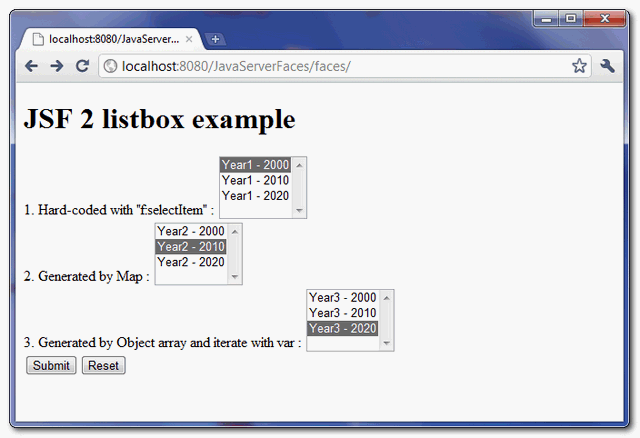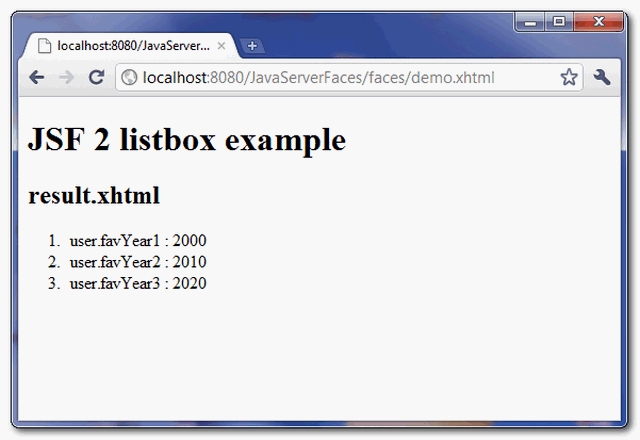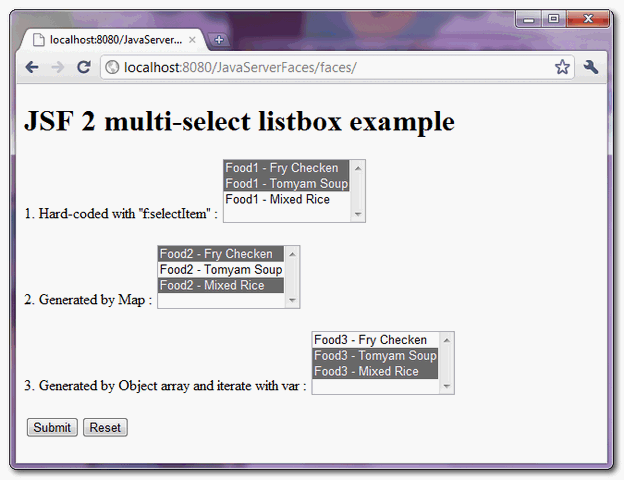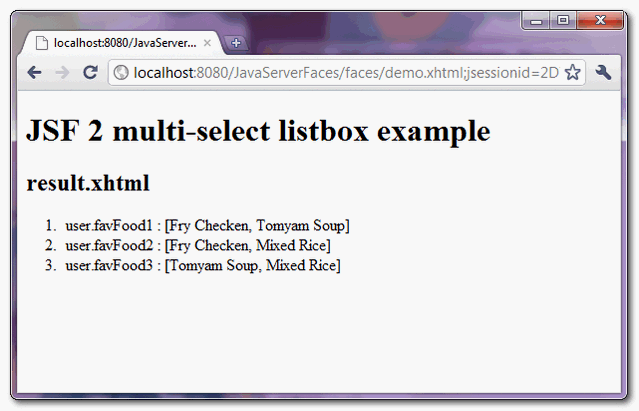In JSF, <h:selectOneListbox /> tag is used to render a single select listbox – HTML select element with “size” attribute.
result.xhtml…
 When “submit” button is clicked, link to “result.xhtml” page and display the submitted listbox values.
When “submit” button is clicked, link to “result.xhtml” page and display the submitted listbox values.

The “favYear1″ listbox, value “2010″ is selected by default.
//JSF... <h:selectOneListbox value="#{user.favYear1}"> <f:selectItem itemValue="2000" itemLabel="Year1 - 2000" /> <f:selectItem itemValue="2010" itemLabel="Year1 - 2010" /> <f:selectItem itemValue="2020" itemLabel="Year1 - 2020" /> </h:selectOneListbox> //HTML output... <select name="j_idt6:j_idt8" size="3"> <option value="2000">Year1 - 2000</option> <option value="2010">Year1 - 2010</option> <option value="2020">Year1 - 2020</option> </select>
h:selectOneListbox example
A JSF 2.0 example to show the use of “h:selectOneListbox” tag to render a single select listbox, and populate the data in 3 different ways :- Hardcoded value in “f:selectItem” tag.
- Generate values with a Map and put it into “f:selectItems” tag.
- Generate values with an Object array and put it into “f:selectItems” tag, then represent the value with “var” attribute.
1. Backing Bean
A backing bean to hold and generate data for listbox values.package com.mkyong; import java.io.Serializable; import java.util.LinkedHashMap; import java.util.Map; import javax.faces.bean.ManagedBean; import javax.faces.bean.SessionScoped; @ManagedBean(name="user") @SessionScoped public class UserBean implements Serializable{ public String favYear1; public String favYear2; public String favYear3; //getter and setter methods //Generated by Map private static Map<String,Object> year2Value; static{ year2Value = new LinkedHashMap<String,Object>(); year2Value.put("Year2 - 2000", "2000"); //label, value year2Value.put("Year2 - 2010", "2010"); year2Value.put("Year2 - 2020", "2020"); } public Map<String,Object> getFavYear2Value() { return year2Value; } //Generated by Object array public static class Year{ public String yearLabel; public String yearValue; public Year(String yearLabel, String yearValue){ this.yearLabel = yearLabel; this.yearValue = yearValue; } public String getYearLabel(){ return yearLabel; } public String getYearValue(){ return yearValue; } } public Year[] year3List; public Year[] getFavYear3Value() { year3List = new Year[3]; year3List[0] = new Year("Year3 - 2000", "2000"); year3List[1] = new Year("Year3 - 2010", "2010"); year3List[2] = new Year("Year3 - 2020", "2020"); return year3List; } }
2. JSF Page
A JSF page to demonstrate the use “h:selectOneListbox” tag.<?xml version="1.0" encoding="UTF-8"?> <!DOCTYPE html PUBLIC "-//W3C//DTD XHTML 1.0 Transitional//EN" "http://www.w3.org/TR/xhtml1/DTD/xhtml1-transitional.dtd"> <html xmlns="http://www.w3.org/1999/xhtml" xmlns:h="http://java.sun.com/jsf/html" xmlns:f="http://java.sun.com/jsf/core" > <h:body> <h1>JSF 2 listbox example</h1> <h:form> 1. Hard-coded with "f:selectItem" : <h:selectOneListbox value="#{user.favYear1}"> <f:selectItem itemValue="2000" itemLabel="Year1 - 2000" /> <f:selectItem itemValue="2010" itemLabel="Year1 - 2010" /> <f:selectItem itemValue="2020" itemLabel="Year1 - 2020" /> </h:selectOneListbox> <br /> 2. Generated by Map : <h:selectOneListbox value="#{user.favYear2}"> <f:selectItems value="#{user.favYear2Value}" /> </h:selectOneListbox> <br /> 3. Generated by Object array and iterate with var : <h:selectOneListbox value="#{user.favYear3}"> <f:selectItems value="#{user.favYear3Value}" var="y" itemLabel="#{y.yearLabel}" itemValue="#{y.yearValue}" /> </h:selectOneListbox> <br /> <h:commandButton value="Submit" action="result" /> <h:commandButton value="Reset" type="reset" /> </h:form> </h:body> </html>
<?xml version="1.0" encoding="UTF-8"?> <!DOCTYPE html PUBLIC "-//W3C//DTD XHTML 1.0 Transitional//EN" "http://www.w3.org/TR/xhtml1/DTD/xhtml1-transitional.dtd"> <html xmlns="http://www.w3.org/1999/xhtml" xmlns:h="http://java.sun.com/jsf/html" > <h:body> <h1>JSF 2 listbox example</h1> <h2>result.xhtml</h2> <ol> <li>user.favYear1 : #{user.favYear1}</li> <li>user.favYear2 : #{user.favYear2}</li> <li>user.favYear3 : #{user.favYear3}</li> </ol> </h:body> </html>
3. Demo


How to pre-select a listbox value?
The value of “f:selectItems” tag is selected if it matched to the “value” of “h:selectOneListbox” tag. In above example, if you set favYear1 property to “2010″ :@ManagedBean(name="user") @SessionScoped public class UserBean{ public String favYear1 = "2010"; //...
Download Source Code
Download It – JSF-2-Listbox-Example.zip (10KB)


